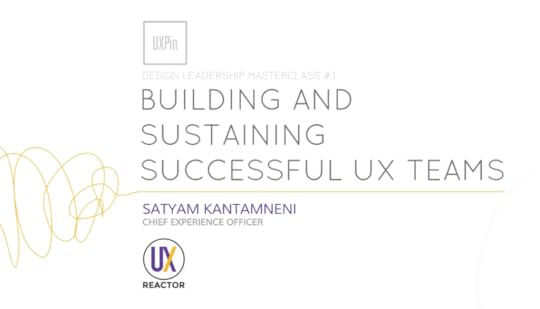Webinar Recap: Building and Sustaining Successful UX Teams

Great UX requires a great team.
We invited Satyam Kantamneni, the Chief Experience Officer at UX Reactor, to join our free Design Leadership Masterclass to talk about how to build and sustain successful UX teams.
Prior to co-founding UX Reactor, Satyam was Managing Director of UX at Citrix and UX Manager at Paypal.
Watch Satyam’s full webinar (attended by 478 people), or read on for our short recap.
After leading design teams for the last ten years, Satyam has come up with four design leadership lessons for his fellow design managers.
What got us here, won’t get us there.
It’s a journey.
Unicorns do not exist.
Manage your UX portfolio.
What Got Us Here, Won’t Get Us There
The past is a great place to learn from, but it’s not a good place to emulate. Like everything else, the field of design is changing quickly.
Everything is going digital. The entire technological landscape has shifted even over the last five years, and it has forced every company to adapt rather suddenly. Companies that have had an entire design team made up of “two or three” designers that handle everything the complex process of user research, prototyping, visual design, and more are being forced to change their ways or risk falling behind.
It’s now time to look towards the future.
It’s A Journey
Organizational change won’t happen quickly. Satyam talks about the “tools” of the journey of building a powerful UX team: people, environment, and process.
People.
It takes a village to create a great user experience for the customer. Not a single designer. An average product development team can have an architect, a front end developer, a Javascript developer, an API developer, an engineer, and a tester. Like product development teams, UX design teams also need a great deal of support from people with different skills. The average UX team can be composed of a user researcher, a prototyper, an interaction designer, and a visual designer.
User researchers are experts in communicating insights. Interaction designers are experts in crafting design systems.Visual designers are experts in design tools and pay extreme attention to detail. Prototypers are great hackers.
Don’t confuse one with the other. Each team member provides unique skillsets.
Environment.
To facilitate a great UX team, the designers need the right work environment.
Companies need to create great physical spaces for their UX teams. Their surroundings need to encourage experimentation and a willingness to fail. They can’t let design teams think that “they’ll just get it right the first time”. Processes should be iterative, and the environment must reflect that.
But beyond the physical environment, the workflow for design teams are important as well. There are many, many tools available for designers today.
At UX Reactor, Satyam’s team uses UXPin and Sketch. Sketch is their main tool for wireframing and mockups while UXPin supports the entire workflow, from ideation to prototyping to validation to development.

Process.
Design leaders must communicate a clear vision and strategy moving forward. To lead the organization, they must:
Identify the problem(s) they are trying to solve
Collect insights from users and customers
Prototype concepts based on insights and hypotheses through validation and iteration
Execute tactically to deliver the results to the customers
To facilitate an efficient process, many companies use the Balanced Scorecard, a strategy performance management tool used by managers to keep track of the execution of activities and the results.

Unicorns Do Not Exist
It’s simple. Unicorns are a myth.
The UX design process is long, complicated, and coordinates many moving parts. Each particular subset of the UX design process requires particular skills that don’t necessarily translate from one to the next. It’s not all the same work.
Unfortunately, many companies today have begun to search for the “unicorn UX designer” that can wear every hat to compensate for a lack of a true design process. Even if a unicorn did exist, it would be wise to be cautious in hiring someone like that.
A designer who can efficiently do user research, prototyping, interaction design, and visual design is someone who likely places a lot of value in himself or herself and may not stay with a company for long, given their inherent value and the likelihood that they may even start their own venture outside of the company.
Instead, companies should seek out T-shaped designers.
Manage Your UX Portfolio
Portfolio management is the art and science of making decisions about investment mix and policy, matching investments to objectives, asset allocation for individuals and institutions, and balancing risk against performance.
Design leaders must manage four sectors of their portfolio.
Talent
Do you have the right people in your organization?
Research Insights
Are you building and communicating relevant insights in your organization?
Design Experiments
Are your experiments diverse and problem focused?
Maturity of Problems
What scale of problems are you tackling? How many projects are CX-focused vs. UX-focused?
Balance your portfolio and make sure that its makeup facilitates an efficient design process.
For example, at UX Reactor, they resource their team as follows: for every one interaction designer, they set aside 0.5 user experience researcher, 0.75 visual designer, and 0.25 prototyper.
Conclusion
If you build your team, environment, and process in an efficient manner and you manage your portfolio correctly, then the process and the structure should sustain itself.
To learn more, watch the first Design Leadership Masterclass Webinar. Check out the session below attended by 478 people.
The post Webinar Recap: Building and Sustaining Successful UX Teams appeared first on Studio by UXPin.
UXpin's Blog
- UXpin's profile
- 68 followers




